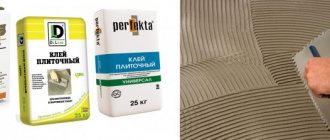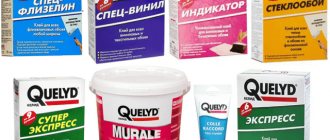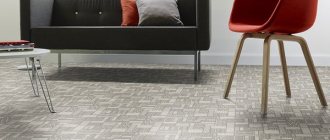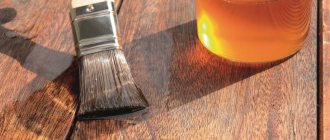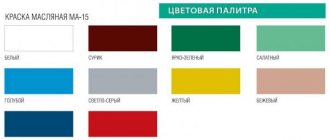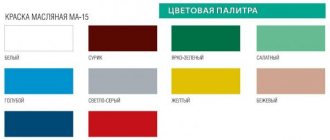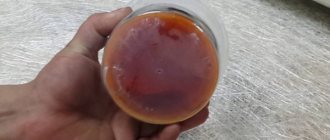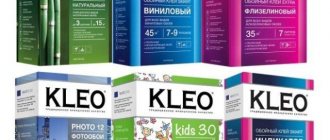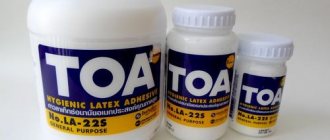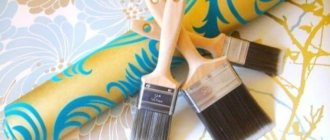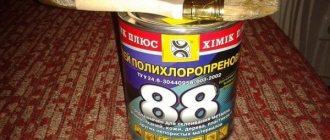Many believe that Russian-made goods are noticeably inferior to their European counterparts. This information can be heard both from specialists (it is no secret that the technology for using imported goods is often better thought out) and sales consultants in construction stores (their own benefit sometimes comes first for them). But the Russian construction market also has its own examples of high-quality products. Among them is KMC wallpaper glue. There are more than a dozen manufacturers of this brand of glue. And all their products meet high quality requirements.
Construction wood glue
Widely used for gluing wood structures (for furniture repair, etc.).
Quality in general depends on proper preparation. The required amount of wood glue is finely chopped and poured with cold water to a depth of 3 cm. This mass must be kept for about noon.
After swelling, drain the top layer of water and place the construction adhesive in a water bath. Heat over low heat, stirring constantly, until completely dissolved.
The temperature of wood glue at the time of preparation should not exceed 70 degrees, because it may lose its properties.
Gluing can be done when the temperature of the glue has reached 30-50 degrees.
When gluing wood along the grain, the surfaces are coated with glue once. Ends - 2 times, allowing the first layer to dry.
The parts to be glued are not pressed immediately, as the hot glue is often squeezed out. Let the wood glue dry for about 3 minutes until the film is stretched, and only then begin gluing.
Connect the parts, rub in a little, moving them slightly, and press or tighten with twine.
Leave to dry for five hours.
If you are repairing old products, first remove the previous layer of construction adhesive. To do this, moisten a rag with water and place it on the glue for two hours.
Scrape off the softened glue with a knife or spatula.
If you add an antiseptic (such as borax, phenol, salicylic acid), it will protect the construction adhesive and materials from mold.
Technical characteristics of CMC glue for wallpaper
As for the name itself, CMC wallpaper adhesive is made on the basis of a special substance called carboxymethylcellulose. For ease of pronunciation and designation, the manufacturers decided to shorten the name by creating an abbreviation based on the initial letters of each of the three parts of the compound word CarboxyMethylCellulose. The result is what we have today, and what we have long been accustomed to - CMC. In appearance, it is a white powdery material consisting of small granules.
CMC is small white granules
As for the main characteristics that must be taken into account when choosing, it is worth paying attention to what color the powder is. Under no circumstances should it be yellow.
Such products, as a rule, are supplied to the market by unscrupulous or even handicraft manufacturers. Such a product not only does not meet gluing standards, but can also ruin the appearance of the wallpaper, for example, if we are talking about paper canvases. Due to the yellow color of the glue, yellow spots may appear on them, which can no longer be corrected, and you will have to re-glue the entire room. An adhesive composition made according to GOST standards must have only a white color. Such products are of the highest quality; when stirred, they form a uniform, homogeneous mass without lumps or sediment.
Attention! Despite the wide range of this product presented in wallpaper and construction stores, you should carefully study each specific type when purchasing. Particular attention should be paid to color
If we consider the classification of this composition in relation to what kind of canvases it is intended for gluing, then three main varieties can be distinguished:
- For light wallpaper.
- For averages.
- For heavier ones.
The viscosity of the solution and, as a result, the ability to reliably glue heavier fabrics, is determined by the level of content of the main raw material - carboxymethylcellulose. The more it is, the correspondingly higher the viscosity of the composition. And even more so, you can glue heavier canvases (for example, vinyl, or even linkrust wallpaper) to the working surface of the walls.
Algorithm for spreading and gluing wallpaper
In recent years, CMC wallpaper glue with additional antiseptic properties has become quite popular. This becomes possible thanks to the use of special additives. Thus, this coating quite successfully prevents the formation and spread of mold and mildew.
Technical data
So, let's list in more detail the main technical characteristics of this glue:
- The dry matter content is at least 57%.
- The proportion of active substance to the total volume of dry matter is at least 69%.
- The share of sodium chloride in the total volume of dry matter is 21%.
- The moisture content of the product is 12%.
- The time for complete swelling to obtain a homogeneous mass does not exceed 2 hours.
- Suitability of a 4% solution is at least 7 days.
It is noteworthy that CMC glue contains special additives that give it insecticide properties and also prevent the paste from rotting. In addition, it is absolutely safe for human health, since its composition is non-toxic.
Moreover. Sometimes it can be added to other solutions, for example, for gluing tiles, to cement- and chalk-based putties, which increases their strength and adhesive characteristics.
CMC can be used to glue different types of wallpaper, as well as other materials
All these characteristics show why this particular product has been so popular in the market for repair and construction products for quite some time. In addition, an important factor is the low price of CMC, which makes it quite affordable for all categories of buyers. Manufacturers manage to maintain competitive prices in order to ensure a consistently high level of sales. By the way, let's now talk about manufacturers.
Types, how to choose
The color of a product is an important characteristic; you should pay attention to it when choosing a product in a store. Glue powder, produced in accordance with GOST standards, is pure white. This product is characterized by excellent quality; when combined with water, it forms a homogeneous mixture without sediment or lumps.
A yellow tint is not acceptable. He usually says that the glue is made in a homemade way by unscrupulous manufacturers. A product like this has the same quality. They usually do not meet the standards of adhesive work, so the result can be very disappointing. For example, after drying, unpleasant yellow stains will appear on paper wallpaper, which can no longer be removed, and you will have to repeat all the work of gluing the wallpaper.
Advice! Despite the large selection of this glue in hardware stores, be sure to carefully study the product before purchasing. Pay special attention to its color.
If we approach the description of CMC glue from the point of view of its purpose, then it is divided into three main groups:
- for installation of light thin wallpaper;
- for medium weight wallpaper;
- for thick, heavy wallpaper.
The thickness and stickiness of the mixture and, as a result, the ability to firmly attach heavy webs, directly depends on the amount of the main substance in the powder - carboxymethylcellulose. If there is a lot of it, then the solution is more viscous, and even heavy vinyl wallpaper will stay securely on the wall.
Types, composition and technical characteristics of wallpaper adhesives
Chemical enterprises produce their own type of CMC for different types of wallpaper. The features of each are indicated on the label or packaging. In any composition, the base substance must be at least 50 percent, and the proportion of sodium chloride must be 21 percent. The humidity of the mixture is up to 12 percent. The solubility of the powder is 96 percent.
CMCs differ in composition and percentage of carboxymethylcellulose. Almost all manufacturers produce universal adhesive that can be used for gluing all types of wallpaper. For each finishing material, its own solution is prepared, in which water is taken in larger or smaller quantities.
For light thin wallpaper
For the thinnest paper wallpapers, it is recommended to use KMC Burny, KMC-N, KMC-1 (Shavings). The form of glue is a white or pink powdery substance, without any odor. Before use, the powder is diluted in water according to the instructions for use. The adhesive solution applied to the surface takes a long time to dry. During the renovation period, make sure that there are no drafts in the room.
Medium weight
Non-woven wallpaper is considered slightly heavier than paper wallpaper. For their gluing, CMC-N or CMC-N Super-Max, Mini-Max, Extra Fast are used. This product is a powder of small granules. The packaging must indicate the type of wallpaper for which the adhesive is used. Any glue is diluted with water according to the instructions.
Thick heavy wallpaper
Inyl wallpaper is considered the heaviest. To cover surfaces with thick wallpaper, use CMC Super Strong. In sTo cover the surface with thick wallpaper, use CMC Super strong. PVA glue is sometimes added to the remainder of the adhesive composition. Externally, glue for heavy wallpaper looks like a white fibrous mass. Before use, the product is diluted with water in the dosage specified in the instructions.
Characteristics of wallpaper glue
A high-quality composition for wallpapering must have certain properties, which we will consider in detail:
- Environmental friendliness and harmlessness are the main requirements for wallpaper glue. Since the type of wall covering in question is used for interior decoration, and most often for wall decoration in living rooms, the adhesive should not release toxic substances into the atmosphere. Fortunately, most modern products are made from harmless components and are considered environmentally friendly.
- The glue should dissolve well in water, forming a homogeneous mass without clots or lumps.
- Wallpaper glue does not dry out too quickly and, when diluted, can be stored for several days if you close the container with a lid and place it in a cool room.
- The above-mentioned feature is also good because the strip glued to the wall can be shifted and moved along the surface for some time. This allows you to straighten the drawing, correct some defects, and achieve an ideal result.
- Most wallpaper adhesives can be used as a primer for plastered walls if these walls are subsequently going to be covered with wallpaper.
Before you buy wallpaper glue, you should familiarize yourself with its characteristics
What you should pay attention to before purchasing material, we will consider below:
The degree of adhesion of the adhesive composition is a very important characteristic, since it determines how firmly the wallpaper will stick to the wall. This indicator is determined by the component composition of the mixture, in particular, the amount of polyvinyl acetate if we are talking about vinyl glue. There are two types of adhesion: initial and final. Initial means the adhesion force of the material to the wall at the moment of contact. Final adhesion determines the degree of adhesion of the wallpaper to the surface after the glue has dried. As a rule, such an indicator in the numerical designation is not contained on a pack of glue, but there you can certainly find information like this: “The composition has high adhesive ability” or “Glides well after contact with the wall”
PVA-based compounds have the highest degree of adhesion; methylcellulose also has good adhesive ability; modified starch has the lowest value. The second characteristic that you should pay attention to is the compatibility of the glue with the type of surface on which you plan to glue the wallpaper. Many manufacturers indicate similar information on product packaging
Often, wallpaper adhesive is suitable for applying it to wood, concrete, plastered, and metal surfaces. When choosing an adhesive, you need to find out the amount of fungicides contained in the component composition of the substance. It is advisable that such additives should not exceed 3%, since an excess of fungicides can adversely affect health. The acid-base indicator of the mixture is also important. The pH level should be 6-7 units, then you can be sure that yellow spots will not appear on the wallpaper. There is another useful characteristic - the moisture resistance of the glue. This ability is useful if the wallpaper will be glued in a very damp room, for example, in the bathroom or kitchen. Wallpaper glue should be non-toxic, environmentally friendly and not emit an unpleasant odor.
Glue consumption
- We figured out how to calculate the amount of wallpaper, there is one small point left, to calculate the glue consumption for the wallpaper. As a rule, all manufacturers indicate this value on the packaging. But you shouldn’t trust these data completely, since they are, to put it mildly, somewhat overestimated.
- In practice, if you act strictly according to the instructions, the quality of the pasting may not meet your expectations. Therefore, we recommend making the composition a little thicker; accordingly, the consumption of wallpaper glue will increase by 1 m2. On average, compared to passport data, the overspending will be about 10%.
- For light, thin canvases, this value will be about 15 - 20 g of dry glue per 1 m².
- Heavy vinyl or non-woven fabric will carry about 45 - 50g per 1m².
- For
The length of wallpaper per roll, which is indicated on the selected wallpaper packaging, is average. So the error in purchasing, especially considering the cost of glue, can be significant in large volumes.
We recommend using a differentiated calculation that takes into account the type of coating and the selected brand of glue. It takes into account a number of parameters, how much wallpaper glue is needed per roll. At the same time, there are also requirements for surface preparation, which, if violated, may increase glue consumption.
Features of use
There is nothing complicated in the procedure for preparing wallpaper adhesive and anyone can handle it. But still, I would like to describe this process in detail so that no questions arise during the work.
First of all, the mixing container is prepared. An enamel bucket or basin is suitable as a container. Then you become familiar with the mixing recommendations, which are indicated on the packaging of CMC glue. Typically, for light fabrics, 500 grams of dry matter and 8 liters of water are taken. For thicker canvases you will need the same amount of dry glue and 7 liters of water to prepare the composition.
Important! Water should only be at room temperature.
Next, the master pours the powder into water with constant stirring. For the composition to swell, you need to wait an average of 3 hours.
You can learn about glue consumption from the information presented on the packaging. But usually a pack of 500 grams is enough to prepare a solution, which will be enough to paste a room with an area of 50 square meters.
When purchasing, you should select the CMC that, according to the technical data, will correspond to the selected type of wallpaper.
Preparation of the solution
The composition of CMC glue consists of shavings formed as a result of processing wood material at the factory.
The prepared solution has high adhesion to many surfaces (concrete, stone, wood, plaster, etc.), except metal. Wallpaper is of varying quality and weight. Before purchasing, the outgoing material is evaluated, since for heavy wallpaper it is better to take a more concentrated product.
Composition of the solution: adhesive powder – 55 percent, sodium chloride – 20 percent; moisture – less than 12 percent. The finished solution will be obtained after 2 hours. To prevent the mixture from spoiling, it is worth adding potassium-aluminum sulfate.
KMC wallpaper glue is the result of processing wood chips at the plant (see photo). It is suitable for gluing to concrete, stone, plaster, wood and other non-metal surfaces all types of wallpaper, on almost any basis, and they can be either washable or non-washable. The composition of CMC glue is beige or white powder in the form of small grains or fibers. The difference between these powders is the concentration of cellulose-glycolic acid (the more it is, the heavier the wallpaper the solution can withstand).
CMC glue
Manufacturers provide detailed instructions on how to properly prepare extra CMC wallpaper glue from shavings with your own hands. It's actually very simple. To prepare the adhesive solution CMC 75v for wallpaper (see photo) you need:
- take a container: basin, bucket, etc.;
- carefully read the instructions on the package, which will indicate in what proportion to dilute the mixture with water;
- heat the water to room temperature;
- pour water into a container and gradually add powder to it, constantly stirring the composition;
- When the proportions are met, mix the resulting solution thoroughly and leave it at rest until ready.
It must be remembered that the adhesive composition must be selected depending on what type of wallpaper will be used and on what surface it will be applied. Only in this case will it be possible to achieve maximum effect.
Until recently, only one type of CMC glue was produced, the basis of which was carboxymethylcellulose, a product of cellulose processing (this substance in the abbreviation gave the glue its name). Now the product is produced by many domestic and even foreign brands, and each company includes various additives in it. Most often they are anti-caking agents and antifungal substances (fungicides):
- hydroxybenzene;
- potassium sulfate;
- aluminum sulfate;
- borax (sodium tetraborate);
- carbolic acid.
Application
So, what do you need to know about preparing the composition and how to dilute CMC glue? In fact, there is nothing complicated about this, and everyone can do all the work with their own hands. To do this, you will need enamel dishes: a bucket, basin or something else. We take the package with glue and find the necessary information on preparation.
Each package has special instructions that tell you how much powder and water you need to take in order to prepare an adhesive solution based on them.
As a rule, the water should be at room temperature. Having found out the proportion indicated in the instructions, we begin to add glue little by little, pouring it into the water, and not forgetting to stir the composition. Then we leave it and wait until it is ready.
Attention! The consumption of CMC glue is indicated by the manufacturer in the corresponding instructions on the packaging.
As noted above, it is necessary to select different types of CMC-extra based on what kind of wallpaper you are going to paste in your room. This adhesive composition is quite versatile and is perfect for gluing such types of fabrics as non-woven, vinyl, paper-based, and even textile (fabric).
You need to prepare wallpaper glue strictly according to the instructions.
In addition to the advantages already listed, it has the following advantages:
- No stains on the surface of the wallpaper.
- Complete absence of unpleasant odor.
- Easy to prepare and use.
- Excellent compatibility with other chemical compounds.
Technical data
What technical characteristics does this glue have?
- It contains at least 57% of the substance in dry form.
- 21% sodium chloride powder.
- 69% is the active substance, taking into account the volume of the substance in dry form.
- Permissible humidity 12%.
- In new formulations, the powder will swell within 2 hours.
- In a week 4% usable. This means that it is best to wallpaper your walls when the mixture is fresh. The composition contains additives that will prevent rot in the paste and it has insecticidal properties. The composition is completely safe (there is a GOST) for human health.
If you want to make putty, you can add this powder to chalk and cement. This composition is also good for pasting a kitchen, bathroom, or toilet room with tiles.
Composition made in Bulgaria
Considering GOST, it becomes clear why this wide range of products is so popular in the domestic market. It is widely used by construction organizations and purchased by private owners for minor repairs. The cost of the glue is low, which only adds to its popularity among regular and potential customers. Manufacturers are interested in a fast and large turnover of products, therefore they keep the cost of goods low, which buyers are happy about.
Related article: The use of glass wallpaper in the bathroom, practical interior
GOST shows that the technical characteristics of the product are normal and there will be no problems during use. This wallpaper glue has an excellent composition with the necessary antiseptic additives. You won’t get poisoned by toxic fumes, you won’t accidentally stick your finger to the wall, everything is fine.
This is the composition, one of the classic ones, used for a long time.
The best posts
- Colored marble: why not?
- How to tile your own bathroom
- Crochet summer hats for women: description with diagrams and video
- Why shouldn't you throw away old furniture?
- DIY cardboard chest of drawers: master class with drawings and diagrams
- DIY ladybug made from a helmet with photos and videos
- How to glue a ceiling plinth to a suspended ceiling with your own hands
- Monkey cross pattern: for the New Year 2022, free, drawing
KMC wallpaper glue technical specifications
CMC glue is a product of the chemical industry and the result of processing wood pulp. The abbreviation CMC translates to carboxymethylcellulose. Simply put, CMC glue is an adhesive made from high-quality cotton cellulose and intended for gluing all types of paper-based wallpaper. The sodium salt of carboxymethylcellulose, on the basis of which CMC glue is produced, is an environmentally friendly product with excellent solubility.
KMC adhesive is universal and is intended for gluing washable and non-washable wallpaper on paper, vinyl, fabric and non-woven bases on concrete, plastered, stone, wood and other non-metallic surfaces.
CMC glue is a white or creamy powdery material with a fine-grained or fibrous structure. The latter are used for gluing only thick wallpaper. The main difference between light and heavier wallpaper adhesives is the concentration of carboxymethylcellulose: the higher it is, the greater the viscosity of such adhesive.
Main technical characteristics of KMC-Kamcel-Standard 500 glue
Dry matter content not less than 50%; Degree of substitution for carboxymethyl groups, within 60-90; Mass fraction of moisture no more than 12%; Swelling time until a homogeneous consistency is obtained - no more than 3 hours; The viability of a 4% solution is at least 7 days.
To prevent rotting of the paste, aluminum-potassium alum or carbolic acid is added to its composition, and an antiseptic and borax preservative are used as an insecticide. CMC glue has antifungal properties (prevents the appearance of mold fungi on the surfaces to be glued) and helps to destroy household insects indoors. CMC glue is fireproof and non-toxic. Sometimes it is used as an additive in mortars, chalk and cement putties to increase their strength, and is even used in the production of sand-lime bricks.
CMC glue today is one of the most common and sought-after products in construction and repair. Also, an important role is played by its relatively low cost with significant and time-tested advantages.
Properties and advantages of CMC glue
CMC glue has excellent adhesive properties; Does not leave stains on the outside of the wallpaper; Odorless; It is an environmentally friendly product; Prevents the formation of fungus; Easy to prepare for use; Mixes well with other ingredients (starch, soap, gelatin) without changing their color; Has high output and return rates.
Areas of application of CMC glue
Oil and gas industries - used as a protective colloid - stabilizer of highly mineralized clay suspensions, regulates the properties of drilling fluids; Textile industry - for sizing warp threads; Mining and processing and mining and chemical industries - during flotation concentration of copper-nickel and sylvinite ores; Foundry - used as a rod fastener; Construction industry - as an adhesive material, for the production of painting compositions, adhesive putties; Paper industry - as an adhesive base for wallpaper, in the preparation of coatings on paper, as an additive to paper pulp to increase the strength of paper. The multifunctional use of CMC glue in various fields of human activity makes this chemical product one of the leaders in the sales market. KMC offers you its services in purchasing glue.
Advantages
In everyday life, as an adhesive for wallpaper, CMC has no equal in popularity. The consumer fell in love with this product due to its excellent qualities. The glue is economical, very easy to prepare and use. This is an environmentally friendly product, non-toxic, odorless. Swells completely without forming sediment. Even if a certain amount of glue gets on the outside of the wallpaper during the sticking process, there will be no stain after drying.
Thanks to its technical characteristics, it provides reliable adhesion to almost any type of surface. It is not susceptible to mold and mildew, which means it can be used in rooms with high humidity. If there is a need to add starch, soap, gelatin, then this can be done without fear: the glue will not change its properties and will not change color.
The glue has a small drawback: it takes quite a long time to swell (up to 2 hours). But this applies only to products from domestic manufacturers. Imported adhesives completely dissolve in about 15 minutes. But they cost an order of magnitude more. So, if you have enough time, then buying expensive instant glue is not practical.
What types of wallpaper glue are there?
Modern wallpaper adhesives are convenient when preparing for work. It is enough to pour the glue into water at room temperature with quick stirring, and after 3, maximum 15 minutes, the glue is ready for use. Gone are the days when you had to soak the glue, bring the mixture to a boil, and then wait for it to cool.
In terms of composition, the glue is available in two types: CMC glue, based on cellulose, and glue based on modified starch.
CMC glue
CMC glue has good adhesive properties. The glue is ready for use no less than three hours after mixing it with water. It has relatively low consumption and low price. A package of CMC glue weighing 500 grams is enough to cover 50 m². The price of a pack is 50-60 rubles.
KMC glue is suitable for gluing any types of wallpaper. For light wallpaper, take 8 liters of water per 500 grams of glue, for heavy and dense wallpaper, prepare thicker glue - 500 grams per 7 liters of water. CMC glue is diluted in warm water and left to swell for 3-8 hours. The swelling time is indicated on the packaging. With such a long time to prepare the glue, it is better to soak it overnight. You soak it in the evening and in the morning the glue is ready for use. Wallpaper glued with CMC glue is difficult to remove during subsequent repairs.
Starch-based adhesive for various types of wallpaper
Based on modified starch, glue is produced for each type of wallpaper. The composition of the glue differs in additives, but the adhesive base is starch, which is an environmentally friendly product. When wallpapering in damp rooms, choose an adhesive that contains antifungal additives.
According to their intended purpose, starch-based wallpaper glue is produced in the following categories:
- Adhesive for paper wallpaper - suitable for all types of paper wallpaper and light vinyl.
- Vinyl wallpaper adhesive - used for thick vinyl wallpaper. Many manufacturers add methylcellulose to the composition of such glue.
- Universal glue - used for all types of wallpaper.
The packaging of universal glue indicates in what proportions the glue should be diluted. For paper wallpaper, the glue is diluted to a liquid consistency. This is necessary to quickly soak the paper base of the wallpaper. Thick glue is difficult to apply evenly on thin wallpaper; after drying, unevenness may form on the wallpaper.
For heavy wallpaper, the glue should be thicker and more viscous than for light paper wallpaper.
4. Glue for non-woven wallpaper. Contains antifungal additives. Glue is applied to the wall.
5. Glue for glass wallpaper. Also suitable for gluing non-woven wallpaper. In addition to modified starch, the composition includes methylcellulose.
How to use correctly
How to prepare the adhesive solution is written in the instructions on the label or packaging. Usually the liquid mass is prepared in a plastic bucket. Take water at room temperature (not hot). First, liquid is poured into the bucket. Then pour in a measured amount of powder in a thin stream, with constant stirring. The glue should be stirred well and left to swell for 15-20 minutes or 2-3 hours.
The time required for infusion is indicated in the instructions.
Typically, a standard package of CMC weighing 500 grams is diluted in 7-8 liters of water. This solution should be enough to cover an area of 50 square meters. Before gluing the wallpaper, the walls are primed with a CMC-based adhesive solution. For this purpose, take 500 grams of glue per ten liters of water. The liquid mixture is applied to the walls and left for 3-4 hours to dry. The wallpaper itself is smeared with adhesive and left to soak, depending on the thickness of the canvas, for 10-20 minutes. Before pasting the walls, the wallpaper is lubricated again with the adhesive mixture.
Carboxymethylcellulose
CMC (n, where x = 0.08-1.5) is a cellulose derivative where the carboxylmethyl group is combined with the hydroxyl groups of glucose monomers. The substance is an acid, therefore it has another name - cellulose-glycolic acid. In practice, sodium salt of carboxymethylcellulose (Na-CMC) is more often used. It was synthesized and patented for the first time in 1918 by the German chemist Jansen.
Properties
Carboxymethyl cellulose is the international name for carboxymethyl cellulose. The physicochemical properties of CMC are described in the table:
| Appearance | Light beige crystalline powder |
| Molecule mass | 240.208 g/mol |
| Chemical formula | C₈H₁₆O₈ |
| Viscosity (1% aqueous solution) | 1000-4000 |
| Losses after drying | 5,0-7,0% |
| pH (1% aqueous solution) | 6,0-8,5 |
| Correspondence | 99,0-99.5% |
| Content of other chemical elements | |
| Sodium (Na) | 7,5-8,5% |
| Iron (Fe) | |
| Lead (Pb) | |
| Arsenic (As) | 0,0002% |
Other physical properties that allow the use of CMC in industry:
- the substance is highly soluble in water;
- with it, aqueous solutions thicken well;
- the viscosity of the substance does not change for a long time;
- holds water;
- capable of forming a transparent, durable film;
- insoluble in oil and fat;
- harmless to the human body;
- tasteless, odorless;
- high-polymer substance resistant to sunlight;
- has a stabilizing and binding effect.
Production
The manufacturing process takes place in several stages and takes a long time. The raw materials used in production are cheap. In industry, the sodium salt of carboxymethylcellulose is obtained by combining alkali cellulose and monochloroacetic acid. There are several production process schemes:
- classical (periodic);
- mono-hardware.
Production includes several important stages. At the first stage, wood or cotton cellulose is treated with a caustic solution in the presence of lower alcohols (they act as organic solvents). Then the alkaline cellulose is treated with monochloroacetic acid at a very high temperature - up to 100 ° C, if a solvent was used, up to 80 ° C - without it. Received product:
- dried;
- crushed;
- pack.
To produce carboxymethyl cellulose, cotton cellulose is used, which is delivered from abroad, and technical cellulose, which is produced in Russia using the sulfate method. Cotton is more preferable for production due to:
- high α-cellulose content (98%);
- long fiber length (10 mm or more);
- high degree of polymerization.
There are high requirements for produced Russian technical cellulose. It should not contain any impurities of heavy metals or chlorine; it must comply with quality standards. Together with known species, other plant raw materials can be used for the production of carboxymethylcellulose. There are known cases of using tree bark, sugar cane, and rice husks. The choice is determined by the affordability of raw materials.
Currently, the Russian Federation uses wood pulp for the production of CMC, while Kazakhstan and Uzbekistan use cotton pulp. The main suppliers of carboxymethyl cellulose to the Russian wood pulp market are Ilim Group OJSC Bratsk and Ust-Ilimsk, Syassky PPM OJSC, Politsell CJSC St. Petersburg. Deliveries for 2022 amounted to about 5.5 thousand tons.
- Proper nutrition for weight loss: menu for every day
- Belarusian surnames - a list of the most common male and female ones, their declension and origin
- How to water cabbage and with what. Watering cabbage in open ground
The advantage over other additives lies in the more viscous properties of the resulting solutions. The absence of taste and smell affects; after adding the substance, a clear solution is obtained. Carboxymethylcellulose improves the quality of the final product by influencing the processes of crystallization, moisture retention and fat absorption. The average cost on the market for 100 grams of ready-made food additive is from 100 to 150 rubles.
General description and purpose
CMC glue is produced at chemical plants based on cellulose. If you decipher the abbreviation CMC itself, you get the word - carboxymethylcellulose. In addition to the cellulose processing product, the glue contains anti-caking agents and antifungal agents. All components, although of synthetic origin, do not cause harm to health.
CMC is designed for gluing various types of wallpaper to any surface (concrete, plaster, wood). Several types of glue are produced. They differ in the percentage of carboxymethylcellulose sodium salt (the higher this figure, the greater the adhesive ability of the glue).
CMC is added to cement mixtures and gypsum putties to increase their strength. This product is used in various industrial sectors. The glue has the appearance of a loose powdery snow-white powder. If the CMC is yellow, it means the product has long expired.
CMC is the most popular repair product due to its ease of use and low cost. Before use, the glue is diluted with water in the dosage specified in the instructions. Then it is left to swell (depending on the type of CMC) for 15 minutes or 2-3 hours. The finished mixture resembles a colorless, gelatinous, viscous mass. The solution never forms clots or lumps, has no odor, and does not leave yellowish stains on the wallpaper. The viability of a 4 percent mixture is as much as seven days.
Where to buy?
We sell high-quality chemicals at the best prices. To order from us, just click on the button next to the product image and enter your contacts.
CMC is the most popular adhesive used for gluing all types of wallpaper. Thanks to its high-quality composition, this product protects against mold, insects, and is not afraid of high humidity, low or high temperatures. CMC comes in the form of a powder, which is diluted with water before use. The finished mixture is non-toxic, odorless, and does not leave stains on the canvas. The adhesive solution is capable of gluing wallpaper to any surface, and CMC is cheaper than other compounds.
Preparation
The operating algorithm can be derived as follows:
- The glue is prepared according to the above method, with precise control of the cooking temperature.
- All bonding surfaces must be dry and clean. The maximum moisture content for wood is no more than 10 percent (veneer - half that).
- The adhesive mass is applied with a bast or bristle brush to both surfaces, the thickness of the seam is 0.1-0.2 mm.
- You need to wait three minutes. This will allow the adhesives to grip securely and not be squeezed out when connecting the parts.
- After fixing the elements, you will need to grind them together.
- It is advisable to tie the parts to be processed with twine or compress them with a clamp.
- Full use of the product is allowed no earlier than after six hours of exposure.
